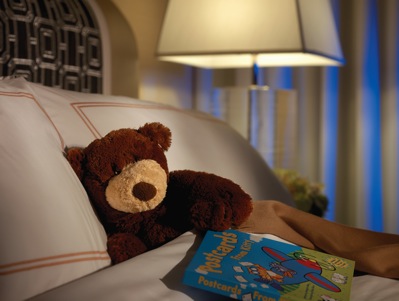Bedtime can be challenging. Kids sometimes feel reluctant to go to bed and allow a good day to come to an end—and on a hard day, it can be even more difficult for kids to relax into sleep. Fortunately, children thrive on routine, and establishing a comforting and predictable series of bedtime activities can be a calming way to end the day and ease your child into sleep.
Start by establishing a schedule for bedtime and for wake-up time as well. It helps to stick with the same schedule on the weekend, too. Making sure that your child gets enough sleep is important when it comes to physical as well as emotional health. The National Sleep Foundation recommends that toddlers between age one and two get 11 to 14 hours of sleep each day, and that preschoolers between ages three and five get 10 to 13 hours.
In the evening, try gradually shifting into your bedtime routine by encouraging quieter activities. Set aside the hour before bedtime for quiet playtime. It’s best to avoid TV or other screen time as the bright light and mental stimulation from screens can make your child more wakeful. For the first part of a bedtime routine, a warm bath can be a time for relaxing play, and it raises the body temperature slightly, also making it easier to feel sleepy.
Another good transitional activity is to give your child a light, healthy bedtime snack about an hour before bed. Young children have small stomachs and need to eat small amounts throughout the day. A bedtime snack that combines protein and carbohydrates can help your child feel sleepy as well as allow him or her to sleep more comfortably during the night and not wake up overly hungry. Try a graham cracker and milk, a whole grain cracker and cheese, or some low-sugar yogurt.
As with any other transition time, it can help to give your child a warning. You might start a familiar bedtime activity, like gathering books to read, so that your child sees it’s almost time for bed. You could also set a timer: tell your child that you’re setting it and that when it goes off, it’s time to get ready for bed. The sound of the timer can be effective as a “third party” reminding both you and your child of bedtime.
Kids like to have clear expectations, so it helps to have a regular series of actions before bedtime: brushing teeth, getting pajamas on, enjoying bedtime books or songs, and so on. Don’t forget to tuck your child in with a comfortable security object or two, such as a favorite blanket and stuffed animal.
For some kids and parents, setting aside a half hour for special, quiet time together at bedtime can be a comforting routine. For others, the togetherness happens earlier in the evening, and bedtime itself is shorter.
As with most things in life, the key is quality rather than quantity. Your bedtime routine doesn’t have to be long, but it needs to be special. It’s a time for a gentle transition into sleep, and a quiet time for togetherness. Make it a time to share something that you and your child enjoy together: play soft music, talk about the fun things you did during the day, or read a favorite story. The best recipe for bedtime is one you come up with based on what most comforts your child.



